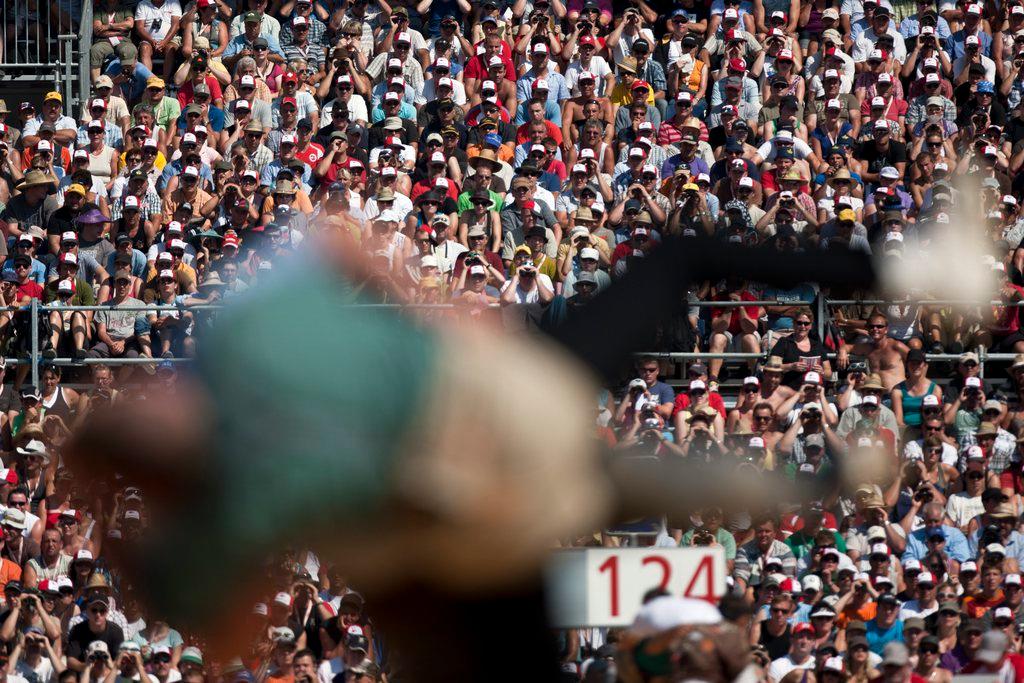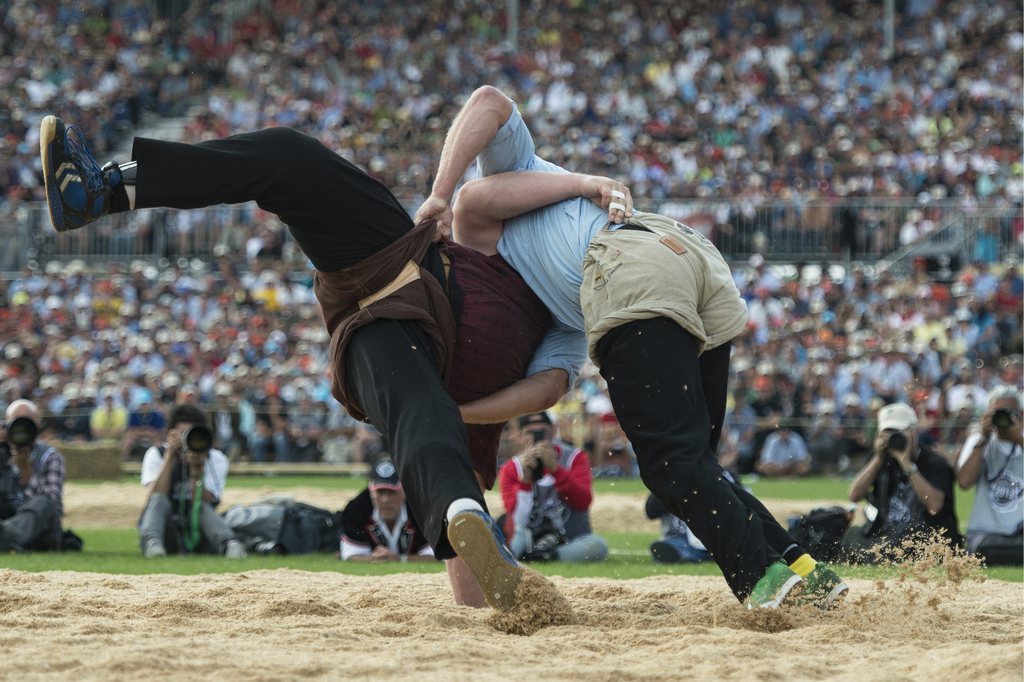Schwingen: from a sawdust ring to a mega-event

Today, even a traditional Swiss sport like “schwingen” – a form of wrestling – is a cash cow. Sponsors play a major role as top competitors meet this weekend to duel on the sport’s biggest stage, but not everyone is happy about that.
From August 30 to September 1, Burgdorf, the capital of the Emmental region, is hosting more than 250,000 spectators at the Federal Wrestling and Alpine Games Festival, held once every three years to find the nation’s champion “schwinger”.
“Once upon a time, there was a Swiss national sport for insiders and wrestling fans,” Ernst Schläpfer, champion in 1980 and 1983, told swissinfo.ch, as if recounting a fairy tale.
But in the last decade, the sport has become more and more of a public spectacle, a “mega-event for everyone”. For him, that trend doesn’t reflect the sport’s original character at all. “A wrestling festival should be a very calm, peaceful event.”
He knows some “genuine schwingen fans“ who are distancing themselves from the sport, “not participating in the hype and not coming to the festival anymore.” He thinks schwingen has reached its limit as far as the size of the events and the media attention are concerned.

More
Grappling with traditions
Today, the top schwingen stars are featured in a pin-up calendar, there are VIP tents next to the sawdust wrestling rings, the stars have lucrative sponsorship deals and the tabloid Blick can claim that “women love wrestlers” – or “bad boys”, “böse Buben” as they are called in German.
But Ernest Schläfli, a six-time winner of the local championships in Schwarzsee in canton Fribourg, about a decade before Schläpfer won his titles, says schwingen has benefited from the media attention.
“The press, radio, and television have brought this sport to the people,” he says, adding that schwingen in Switzerland has “developed fantastically” thanks to the enormous media interest.
The champion of the last federal wrestling festival in 2010, 23-year-old Kilian Wenger, counts Migros, Raffeisen Bank, John Deere and the Opel car company among the dozen or so sponsors backing him as he defends his title this year.

More
Wrestling festival crowned with success
Schwingen? Forbidden!
For all its popularity today, schwingen was actually forbidden at certain times in Switzerland’s history. According to the Swiss Schwingen Federation, in the 16th and 17th centuries the authorities feared that schwingen would keep people away from church. Because schwingen was often done on religious holidays, it kept being made a punishable offence.
Competitors in this Swiss version of wrestling wear special burlap shorts over their trousers with a slit at the back that allows the opponent to grip the belt.
The contest involves one round lasting 10-12 minutes.
The winner is the one who throws his opponent onto his back with both shoulder blades touching the ground without losing his grip on his opponent’s shorts. If neither wrestler succeeds in the allotted time, that round is called a draw.
The Federal Wrestling and Alpine Games Festival is the country’s largest wrestling event and takes place every three years. It consists of eight rounds of wrestling over two days. The winner holds the title of “Wrestling King” for three years.
(Source: Presence Switzerland)
But the beginnings of the Swiss national sport go much further back, says Schläpfer, who has delved deep into its history.
“Schwingen is an ancient sport that has been around for a very long time. It differs from other forms of wrestling because competitors kept their normal clothes on and used them as leverage when fighting. Originally, these were the trousers they wore every day, just rolling them up for the fight.”
That’s the difference with Graeco-Roman and freestyle wrestling, which were originally done naked, according to Schläpfer.
The first pictorial representations of the typical wrestler’s grip on his opponent’s belt go back to the 13th century, and the very oldest is in Lausanne cathedral. For that reason, schwingen is often called the “trouser lift,” or “Hosenlupf” in Swiss German.
Schwingen used to give the men of one valley a chance to test themselves against those from elsewhere. “The classic test was on the Brünig pass, where wrestlers from central Switzerland would meet those from the Bernese region to see who was the strongest,” says Schläpfer.
Search for identity
The ban on schwingen ended in the 18th century with the Enlightenment. According to the Swiss Schwingen Federation, the alpine games festival at the ruins of the Unspunnen castle near Interlaken in 1805 was the spark that revived the sport.
This went hand-in-hand with a growing assertion of Swiss identity, after France had imposed a single regime on most of Europe. “The reason for holding this festival was clearly to raise the Swiss consciousness,” the federation writes.
“We’re now in a similar phase,” says Schläpfer. At a time of globalisation, many people are in search of identity, looking for the “real Switzerland”.
The Federal Wrestling and Alpine Games Festival has been held regularly since 1895, and every three years since 1974.
The 2013 games are the 43rd. They are being held between August 30 and September 1 in Burgdorf, the capital of the Emmental region.
Three sports will be represented: schwingen, stone throwing – which involves throwing a heavy stone (the heaviest weighing 83.5 kg) as far as possible – and hornussen (a sport described variously as “Swiss golf” and “Swiss cricket”).
Schwingen is one of the so-called national sports of Switzerland, together with stone throwing and, to some degree, hornussen, according to the Historical Dictionary of Switzerland.
More than 250,000 spectators are expected at the event.
The largest stadium in Switzerland, the Emmental-Arena, was built in Burgdorf especially for the event. It has seating for more than 52,000 and will be dismantled at the end of the festival.
Four thousand volunteers will be present at the event, which has a budget of CHF25 million ($26.8 million).
(Source: Federal Wrestling and Alpine Games Festival 2013)
“They want to feel distinct from the rest of the world and from Europe. And of course, sports and traditions like this help them to do so.” This yearning is, “at least superficially”, one factor in the success of schwingen, he believes.
“In the old days, the spectators smoked cigars and wore hats,“ says Schläfli, who has been working hard to organise the next Federal Wrestling and Alpine Games Festival in 2016 in the village of Estavayer-le-Lac in canton Fribourg.
Times have changed. He has observed how nowadays many young people – of both sexes – are getting interested in the sport. “About 30 to 40 per cent of spectators are female,” he notes.
And the sport is becoming increasingly popular among the French-speaking population. “When I was taking part as a wrestler, you barely heard French,” says Schläfli. “Now, you hear it much more often.”
The modernisation and the many changes in his sport don’t bother him. “We live in the year 2013,” he points out. The only thing that hasn’t changed is the technique. “You still have to throw your opponent onto his back, and the moves are the same as in my time,” he says with a chuckle.
Ministers mixing with farmers
But Schläpfer has more trouble accepting the recent changes to the sport. In the VIP tents, he sees “the creation of a two or three-tier class system, as you have at football matches.” For him this is “a very dangerous development”. What used to be typical of schwingen was precisely the lack of any such divide.
“For a whole day, cabinet members would sit next to farmers, and people couldn’t help but start talking to each other.” This informality “is now disappearing under pressure from sponsors and marketing people”.
Schläpfer, whose first federal wrestling festival victory at the age of 24 “more or less“ helped him finance his studies, is glad that “big business” hadn’t yet started taking an interest in the wrestling ring in his day.
“I prefer to be financially independent instead of having to be at the beck and call of some big company,” he says, commenting on the situation many of today’s top wrestlers find themselves in.
And suddenly, their world seems anything but a fairy tale.
(Translated from German by Veronica DeVore)

In compliance with the JTI standards
More: SWI swissinfo.ch certified by the Journalism Trust Initiative









You can find an overview of ongoing debates with our journalists here . Please join us!
If you want to start a conversation about a topic raised in this article or want to report factual errors, email us at english@swissinfo.ch.